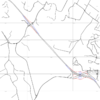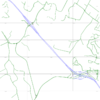Can you link some of these too?
I didn't saved those so I started searching for them again. Because of this I realized that there is one more common reason for those places to show up - power cables. Low hanging cables above the road seem to be another source of radar echo. That explained some situations.
This time I assumed, that this value ranging up to 100 is a probability of existence (or something like that). That means we should not trust places with this value in low ranges, so I search only in entries with "probability" > 80 (although I still don't know if that is its meaning). Turns out it is quite hard to find those "unexplained" places that way. When looking only at the places with large "probability" almost always there is a sign/board/lights above the road, bridge, power cables, or trees most likely responsible. And there are a lot of sections caused by trees.
I had some strange places previously, now I can't find them. Here are couple examples of more unexplained ones that I managed to find this time:
Link
Link
Link
Link
What about multiple lanes? There should be a flag that enable auto lanechange (or number of lanes data) as well I would think.
There are a bunch of boolean flags (or other single byte values) for each spline that I mostly don't understand. I don't have any hint for their meaning, and all I can do is to look on the map for context and try to draw some conclusions.
There is a flag probably indicating that the section is a road with traffic in opposite directions (as not a road with some/any divider between the lines, even on local roads). There is a flag for parking lots (and only local parking lot routes, not just roads with parking spaces on sides).
There is a value indicating whether a path is an off-ramp, or an on-ramp, like this:

There is a flag active mostly for non-highway roads, and two flags active mostly for highways and highway ramps, that I'm not sure about their specific meaning. Here is an example (green when one flag active, blue when second flag active):

There are three more flags activated in patterns so random, that I don't even know where to start.
Structures in this file also have quite dynamic nature. That is, any field can be present or not, and it can grow in new versions with full backward compatibility. There are three fields that are empty in all tiles that I checked. Maybe they are not used anymore, or maybe I have bad luck. Anyway, there is still more information there that I still don't understand.







